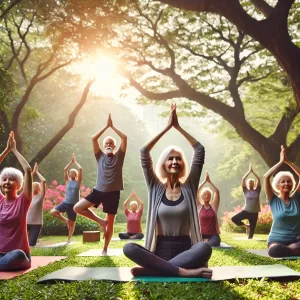
Yoga for Seniors: Maintaining Mobility and Strength

Seniors practicing yoga in a peaceful park setting — they look relaxed and happy in their poses.
As we age, staying active and maintaining physical and mental well-being becomes increasingly important. Yoga is an excellent practice for seniors, offering a gentle yet effective way to improve mobility, build strength, and enhance overall quality of life. This article delves into the numerous benefits of yoga for seniors, the best poses to try, safety tips, and how to build a consistent, enjoyable routine.
The Importance of Staying Active as We Age
Aging naturally brings changes to the body — joints become stiffer, muscles weaken, and balance may decline. These changes can affect independence and increase the risk of falls or injuries. Regular physical activity helps combat these issues, but high-impact exercises may feel too demanding for older adults. Yoga, with its low-impact, adaptable movements, emerges as a powerful solution.
Yoga isn’t just about stretching; it integrates breath control, gentle movement, and mindfulness. This combination helps seniors maintain physical vitality while supporting mental well-being. Let’s explore these benefits more closely.
Benefits of Yoga for Seniors
- Improved Flexibility and Mobility:
- Regular yoga practice gradually loosens tight muscles and enhances joint flexibility. This is particularly beneficial for seniors who experience stiffness from arthritis or general aging.
- Increased Strength:
- Yoga engages various muscle groups through controlled, weight-bearing poses. This helps seniors maintain strength in critical areas like the legs, core, and back, supporting posture and everyday movements.
- Enhanced Balance and Coordination:
- Balance tends to decline with age, raising the risk of falls. Poses like Tree Pose or Warrior help improve stability by strengthening the core and leg muscles.
- Joint Health:
- Gentle movements in yoga stimulate blood flow to the joints, promoting lubrication and reducing discomfort from stiffness or arthritis.
- Better Breathing and Lung Capacity:
- Yoga’s breathing exercises (pranayama) expand lung capacity and promote better oxygenation, benefiting respiratory health — especially crucial for seniors with conditions like asthma or COPD.
- Mental Clarity and Emotional Well-being:
- Yoga’s meditative nature reduces stress, anxiety, and depression. It encourages mindfulness and relaxation, fostering a positive mindset.
- Pain Relief:
- Studies suggest that yoga can help alleviate chronic pain, including back pain, osteoarthritis, and fibromyalgia — common issues among older adults.
- Improved Sleep:
- Yoga promotes relaxation and reduces insomnia, helping seniors enjoy more restful sleep.
Best Yoga Poses for Seniors:-
Here’s a selection of beginner-friendly, effective poses for seniors to improve strength and mobility:
- Mountain Pose (Tadasana):
- Enhances posture, balance, and core strength.
- Chair Pose (Utkatasana):
- Strengthens the thighs and improves endurance. A sturdy chair can assist with balance.
- Cat-Cow Stretch (Marjaryasana-Bitilasana):
- Increases spinal flexibility and relieves back tension.
- Tree Pose (Vrikshasana):
- Improves balance and leg strength. Hold onto a wall or chair for support if needed.
- Seated Forward Bend (Paschimottanasana):
- Stretches the hamstrings and lower back while promoting relaxation.
- Bridge Pose (Setu Bandhasana):
- Strengthens the lower back, glutes, and thighs while opening the chest and improving spinal flexibility.
- Corpse Pose (Savasana):
- Promotes deep relaxation and mindfulness. Ideal for ending a yoga session.
Safety Tips for Seniors Practicing Yoga
- Consult a Healthcare Provider:
- Before starting yoga, seniors should consult their doctor — especially if they have existing medical conditions or joint issues.
- Start Slowly:
- It’s essential to begin with gentle poses, focusing on comfort rather than pushing too hard.
- Listen to Your Body:
- Pain is a signal to stop. Seniors should prioritize ease and enjoyment over intensity.
- Use Props:
- Chairs, yoga blocks, and straps provide support and prevent strain.
- Practice Balance Near a Wall:
- For balance-focused poses, standing near a wall offers stability and confidence.
- Stay Hydrated:
- Seniors may not feel thirsty as easily, but hydration is crucial before and after yoga.
- Focus on Breathing:
- Breathing deeply and steadily enhances movement and relaxation.
Creating a Consistent Yoga Routine
Building a sustainable yoga habit is key to enjoying long-term benefits. Here are a few tips to help seniors establish a routine:
- Set Realistic Goals: Start with 10-15 minutes per day, gradually increasing duration.
- Pick a Suitable Time: Mornings can energize the day, while evenings promote relaxation.
- Join a Senior-Friendly Class: Many yoga studios and community centers offer specialized classes for older adults.
- Explore Online Resources: For those preferring home practice, numerous beginner-friendly yoga videos are available online.
- Make It Enjoyable: Pair yoga with calming music, practice in a sunny spot, or invite a friend to join.
Final Thoughts
Yoga is an empowering, adaptable practice for seniors seeking to maintain mobility, strength, and overall well-being. Its physical and mental benefits make it an ideal addition to a healthy, active lifestyle — no matter your age or fitness level. By starting slowly, prioritizing safety, and cultivating a consistent routine, seniors can embrace yoga as a lifelong tool for enhancing vitality and peace.
So, whether you’re a senior yourself or have a loved one in mind, encourage them to give yoga a try. It’s never too late to start a journey toward better health and greater flexibility — one gentle stretch at a time.